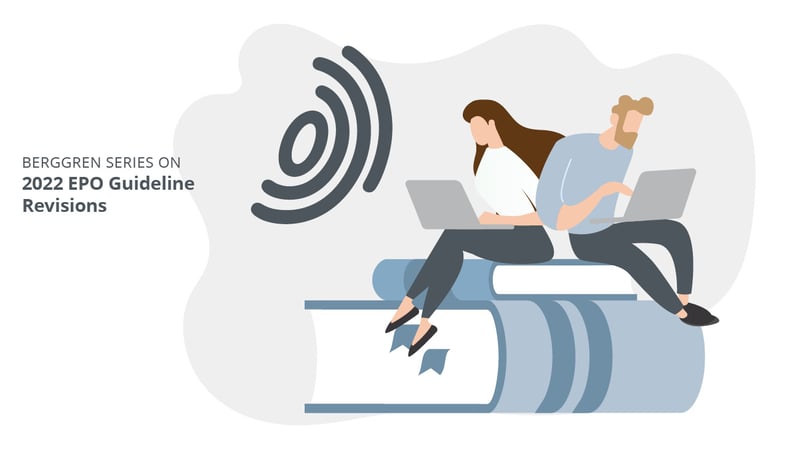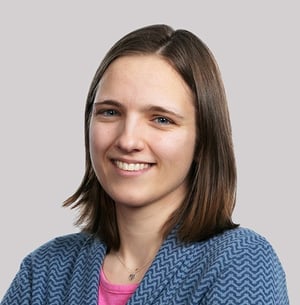In this seventh and final article of our 2022 weekly series addressing updates to the European Patent Office’s (“EPO”) Guidelines for Examination (“the Guidelines”), we summarize below some of the remaining notable changes to the Guidelines.
As a recap, the previous articles in our EPO Guidelines update series addressed (1) amendments to the description, (2) partial priority, (3) mathematical methods and AI, (4) simulations and other computer-implemented inventions, (5) oral proceedings, and (6) changes to biotech inventions and morality issues.
Removal of requirement for inventor’s full address
Following the amendment of Rules 19 and 143 EPC, section A-III, 5.3 of the new Guidelines has been updated to state that the designation of the inventor must contain the family name, given names and country and place of residence of the inventor. Previously, the full address of the inventor was required. The new guidelines further clarify that the place of residence is the city or municipality, i.e., not the province or region, where the inventor permanently resides and should preferably include the postal code where available. Alternatively, the country and place of residence also can be that of the applicant (e.g., the inventor’s employer).
In addition, section A-III, 5.4 of the previous edition of the Guidelines, which explained that inventors would be notified by mail of their designation in the application, has now been removed from the new Guidelines.
Availability of electronic signatures for assignment documents
Section E-XIV, 3 has been updated to specify that assignment documents filed electronically may bear qualified electronic signatures instead of handwritten signatures. This significantly simplifies practice for many parties, where qualified electronic signatures are becoming the norm. A qualified electronic signature is one that satisfies all of (a)-(e) below:
(a) is uniquely linked to and capable of identifying the person signing
(b) is created by means that the person signing can use with a high level of confidence and over which they have sole control
(c) is associated with the electronic document to be authenticated in such a way that any subsequent change in the data is detectable
(d) is created by a qualified electronic signature device
(e) is based on a qualified certificate
Qualified signatures include popular digital signature software like AdobeSign or DocuSign.
In some countries, such as Finland, strong government-enabled identification makes electronically signing documents trivial even for individuals, but in many other countries it will be necessary for parties to obtain a digital certificate in order to sign electronically. It may therefore remain easier to obtain wet-ink signatures for many assignments, particularly those involving individual inventors.
Central Fee Payment – a new online service
Sections A-X, 4.2.3 and A-X, 4.4 have been updated to include information on the new online Central Fee Payment service. The current Online Fee Payment system is expected to be replaced by the Central Fee Payment system and should allow centralised way to pay fees and claim refunds across the entire patent grant procedure, via all permitted payment methods including by deposit account.
Until the migration to the new system is complete, however, users can continue to submit debit orders via the Online Fee Payment service. In addition, the ability to pay fees via EPO Online Filing and Online Filing 2.0 will not be affected and remains the easiest way to pay fees at the same time as handling another action, such as filing a response to an EPO communication.
Changes to priority-related procedures
While we have already discussed the updates to partial priority in one of our previous articles, several additional changes in the new Guidelines related to priority claims are worth mentioning.
For example, section A-III, 6.1 has been updated to clarify that if the previous application was filed by joint applicants – all of these joint applicants must be amongst the applicants of the later European patent application or have transferred their rights in the priority application to the applicant of the later European patent application. This is the so-called joint-applicants approach, which is now the subject of a referral to the Enlarged Board of Appeal, and which we discussed in more detail here. Until the decision has been issued, all examination and opposition proceedings before the EPO in which the decision depends entirely on the outcome of the referrals will be stayed.
Section A-III, 6.7 has been updated to reflect the end of the Priority Document Exchange (PDX) agreements between various national patent offices and the EPO. As a result, copies of Chinese, Korean and US priority applications will no longer be included in the file of the EP application by default. In the future, the only priority applications that will be automatically included in the file of the EP application are earlier-filed EP applications and PCT applications where the EPO was the receiving office. For all others, it will be necessary to request retrieval via the WIPO Digital Access Service or to file a physical certified copy.
Section A-III, 6.12 has been updated to add that applicants claiming priority from a first filing made in People’s Republic of China and Sweden are also exempted from filing a copy of search results under Rule 141(1) EPC.
Changes to electronic filing
The EPO’s Online Filing (CMS) service was decommissioned on 1 January 2022, leaving the options of filing electronically using EPO Online Filing (OLF) and using the new Online Filing 2.0 or the EPO’s web-form filing service (web-form filing). The replacement of CMS by Online Filing 2.0 is reflected in several sections of the Guidelines.
Clarity of terms such as “substantially” and “approximately”
Sections F-IV, 4.7.1 and 4.7.2 have been clarified to make clear that the interpretation of terms such as “substantially” or “approximately” can be affected by the text of the application as well as by the general knowledge of the skilled person. Care should be taken, however, that use of these terms does not contradict the normal meaning of a term as understood by the skilled person. For example, defining a 20-sided polygon as “substantially circular” would render the scope of a claim unclear, because it is not clear where the limit of “substantially circular” lies – would, for example, a 19-sided or 18-sided polygon still be “substantially circular”?
Clarifications related to languages and translations
A sentence has been added to section A-X, 9.2.3 to clarify that if the request for examination in an admissible non-EPO language was filed subsequent to EPO Form 1001 or EPO From 1200, a translation of the request for examination in the language of proceedings, i.e., English, French or German, must be re-filed.
Double patenting
Although it has been an established practice at the EPO that two patents cannot be granted to the same applicant for the same subject matter, the exact legal mechanism for refusing the grant of two patents was previously unclear, as there is no explicit prohibition for double patenting in the EPC. Section G-IV, 5.4 on double patenting has been now updated in view of the decision in G 4/19, which has confirmed the prohibition on double patenting to be applicable under Article 125 EPC as a principle of procedural law generally recognised in the Contracting States. The new wording in the Guidelines thus clarifies the legal basis to be used for a double patenting objection. It is worth noting, however, that the meaning of terms “the same subject matter”, “same invention”, and “same applicant” have not been addressed in G 4/19, and the new guidelines do not clarify the topic any further. Hence, the extent to which the double patenting prohibition applies remains somewhat unclear.
Blog writers: Vilgaile Dagyte and Michael Nielsen.




